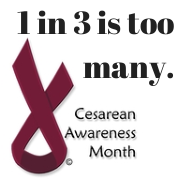April 09, 2014
April is Cesarean Awareness Month - Resources and a Test Your Knowledge Quiz
By: Sharon Muza, BS, LCCE, FACCE, CD/BDT(DONA), CLE | 0 Comments
 April is Cesarean Awareness Month, an event meant to direct the American public's attention to the United States' high cesarean rate. 32.8% of all birthing women gave birth by cesarean in 2012. A cesarean delivery can be a life-saving procedure when used appropriately, but it takes one's breath away when you consider that one third of all women birthing underwent major abdominal surgery in order to birth their babies.
April is Cesarean Awareness Month, an event meant to direct the American public's attention to the United States' high cesarean rate. 32.8% of all birthing women gave birth by cesarean in 2012. A cesarean delivery can be a life-saving procedure when used appropriately, but it takes one's breath away when you consider that one third of all women birthing underwent major abdominal surgery in order to birth their babies.
Professionals that work with women during the childbearing year can be a great resource for women, pointing them to evidence based information, support groups and organizations that offer non-biased information to help women lower their risk of cesarean surgery, receive support after a cesarean and work towards a trial of labor after a cesarean (TOLAC) and achieve a vaginal birth after a cesarean (VBAC) for subsequent births if appropriate.
Here are my top suggestions for websites and resources every birth professional should have on their short list to share with students and clients when it comes to cesarean awareness.
1. International Cesarean Awareness Network - an international organization with almost 200 volunteer led chapters, (most in the USA) offering peer to peer support for cesarean recovery and VBAC information by way of a website, e-newsletters, webinars, online forums, Facebook groups and monthly meetings in the community.
2. VBACFacts.com - Led by birth advocate Jen Kamel, this website is big on research and helps consumers and professionals alike understand the evidence and risks and benefits of both repeat cesareans and vaginal birth after cesarean, including vaginal birth after multiple cesareans.
3. Lamaze International's "Push for Your Baby" - is a great resource for families to learn about the Six Healthy Care Practices, what evidence based care looks like and how to work with your health care provider to advocate for a safe and healthy birth. Also Lamaze has an wonderful infographic that can be shared online or printed.
4. Spinning Babies - Midwife Gail Tully really knows her stuff when it comes to helping babies navigate the pelvis during labor and birth. Many cesareans are conducted for "failure to progress" or "cephalopelvic disproportion" when really it is a case of a malpositioned baby who needed to be in a different position. This website is a wealth of information on what women can do to help their babies into the ideal position to be born, prenatally and during labor. It includes valuable information about helping a breech baby turn vertex. This is important, because finding a health care provider who will support vaginal breech birth is like finding a needle in a haystack.

© Patti Ramos Photography
5. Childbirth Connection - This website is a virtual goldmine of evidence based information about cesareans and VBACs including a valuable guide "What Every Pregnant Woman Needs to Know about Cesareans." There are questions to ask a care provider and includes information on informed consent and informed refusal.
6. Cesareanrates.com is a great website run by Jill Arnold for those who love the numbers. Find out the cesarean rates of hospitals in your area. All the states are represented and families can use the information when searching out a provider and choosing a facility. Jill's resource page on this site is full of useful information as well.
7. Safe Prevention of the Primary Cesarean - The American Congress of Obstetricians and Gynecologists along with the Society for Maternal Fetal Medicine recently published a groundbreaking document aimed at reducing the first cesarean. While fairly heavy reading, there is so much good information in this committee opinion that I believe every birth professional should at least take a peek. You may be pleasantly surprised.
Test your knowledge of the facts around cesareans and VBACs with this informative quiz:
Play the Cesarean Awareness Month 2014 quiz on QuizRevolution now!
As a birth professional, you can be a great resource for all your clients, helping them to prevent their first cesarean, providing support if they do birth by cesarean and assisting them on the journey to VBAC by pointing them to these valuable resources. You can make every day "Cesarean Awareness Day" for the families you work with, doing your part to help the pendulum to swing in the other direction, resulting in a reduction in our national cesarean rates and improving outcomes for mothers and babies. What are your favorite resources on the topic of cesareans and VBACs? Share with us in the comments section.
Images
- Patti Ramos
- creative commons licensed ( BY-NC ) flickr photo shared by Neal Gillis
- creative commons licensed ( BY-SA ) flickr photo shared by remysharp
- creative commons licensed ( BY-NC-SA ) flickr photo shared by mikeandanna
- creative commons licensed ( BY-NC-SA ) flickr photo shared by mikeandanna
- creative commons licensed ( BY-SA ) flickr photo shared by Kelly Sue
- creative commons licensed ( BY ) flickr photo shared by Marie in NC
- creative commons licensed ( BY-NC-SA ) flickr photo shared by lucidialohman
- creative commons licensed ( BY-NC-ND ) flickr photo shared by soldierant
- creative commons licensed ( BY-NC-SA ) flickr photo shared by emergencydoc
- creative commons licensed ( BY-NC-ND ) flickr photo shared by Mwesigwa
Tags
Childbirth education Childbirth Connection Cesarean Awareness Month VBAC ACOG Lamaze International Spinning Babies ICAN Labor/Birth Maternal Infant Care Help and Training Cesarean Section SMFM Cesareanrates.com VBACFacts.com